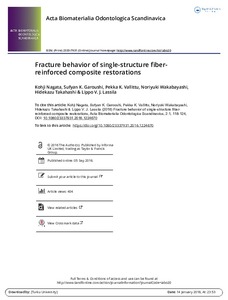Fracture behavior of single-structure fiber-reinforced composite restorations
Vallittu PK; Wakabayashi N; Lassila LVJ.; Garoushi SK; Nagata K; Takahashi H
https://urn.fi/URN:NBN:fi-fe2021042717624
Tiivistelmä
Objective: The applications of single-structure fiber-reinforced composite (FRC) in restorative dentistry have not been well reported. This study aimed to clarify the static mechanical properties of anterior crown restorations prepared using two types of single-structure FRC. Materials and methods: An experimental crown restoration was designed for an upper anterior incisor. The restorations were made from IPS Empress CAD for CEREC (Emp), IPS e.max® CAD (eMx), experimental single-structure all-FRC (a-FRC), Filtek™ Supreme XTE (XTE), and commercially available single-structure short-FRC (everX Posterior™) (n = 8 for each material) (s-FRC). The a-FRC restorations were prepared from an experimental FRC blank using a computer-aided design and manufacturing (CAD/CAM) device. A fracture test was performed to assess the fracture load, toughness, and failure mode. The fracture loads were vertically applied on the restorations. The surface micromorphology of the FRC restorations was observed by scanning electron microscopy (SEM). The data were analyzed by analysis of variance (p = .05) followed by Tukey's test. Results: s-FRC showed the highest mean fracture load (1145.0 ± 89.6 N) and toughness (26.2 ± 5.8 Ncm) among all the groups tested. With regard to the micromorphology of the prosthetic surface, local crushing of the fiberglass was observed in s-FRC, whereas chopped fiberglass was observed in a-FRC. Conclusions: The restorations made of short-FRC showed a higher load-bearing capacity than those made of the experimental all-FRC blanks for CAD/CAM. The brittle-like fractures were exhibited in the recent dental esthetic materials, while local crushing fractures were shown for single-structure FRC restorations.
Kokoelmat
- Rinnakkaistallenteet [19250]
